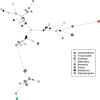How ancient forest fragmentation and riparian connectivity generate high levels of genetic diversity in a microendemic Malagasy tree
- PMID: 36320175
- PMCID: PMC10100191
- DOI: 10.1111/mec.16759
How ancient forest fragmentation and riparian connectivity generate high levels of genetic diversity in a microendemic Malagasy tree
Abstract
Understanding landscape changes is central to predicting evolutionary trajectories and defining conservation practices. While human-driven deforestation is intense throughout Madagascar, exceptions in areas such as the Loky-Manambato region (north) raise questions regarding the causes and age of forest fragmentation. The Loky-Manambato region also harbours a rich and endemic flora, whose evolutionary origin remains poorly understood. We assessed the genetic diversity of an endangered microendemic Malagasy olive species (Noronhia spinifolia Hong-Wa) to better understand the vegetation dynamics in the Loky-Manambato region and its influence on past evolutionary processes. We characterized 72 individuals sampled across eight forests through nuclear and mitochondrial restriction-associated DNA sequencing data and chloroplast microsatellites. Combined population and landscape genetics analyses indicate that N. spinifolia diversity is largely explained by the current forest cover, highlighting a long-standing habitat mosaic in the region. This sustains a major and long-term role of riparian corridors in maintaining connectivity across these antique mosaic habitats, calling for the study of organismal interactions that promote gene flow.
Keywords: Madagascar; Malagasy olive; RADseq; connectivity; cpSSR; gene flow; habitat loss and fragmentation; habitat mosaic; landscape genetics; mitochondrial DNA.
© 2022 The Authors. Molecular Ecology published by John Wiley & Sons Ltd.
Conflict of interest statement
The authors of this article declare no financial conflicts of interest with its content.
Figures




Similar articles
-
Stuck in fragments: Population genetics of the Endangered collared brown lemur Eulemur collaris in the Malagasy littoral forest.Am J Phys Anthropol. 2017 Jul;163(3):542-552. doi: 10.1002/ajpa.23230. Epub 2017 Apr 21. Am J Phys Anthropol. 2017. PMID: 28429848
-
Small effect of fragmentation on the genetic diversity of Dalbergia monticola, an endangered tree species of the eastern forest of Madagascar, detected by chloroplast and nuclear microsatellites.Ann Bot. 2009 Nov;104(6):1231-42. doi: 10.1093/aob/mcp231. Epub 2009 Sep 22. Ann Bot. 2009. PMID: 19773273 Free PMC article.
-
Effects of Forest Fragmentation on Connectivity and Genetic Diversity in an Endemic and an Invasive Rodent in Northwestern Madagascar.Genes (Basel). 2023 Jul 15;14(7):1451. doi: 10.3390/genes14071451. Genes (Basel). 2023. PMID: 37510355 Free PMC article.
-
Genetic Diversity of the Ring-Tailed Lemur (Lemur catta) in South-Central Madagascar.Folia Primatol (Basel). 2015;86(1-2):76-84. doi: 10.1159/000368668. Epub 2015 May 19. Folia Primatol (Basel). 2015. PMID: 26022303
-
Trends in forest fragment research in Madagascar: Documented responses by lemurs and other taxa.Am J Primatol. 2020 Apr;82(4):e23092. doi: 10.1002/ajp.23092. Epub 2020 Jan 20. Am J Primatol. 2020. PMID: 31960516 Review.
Cited by
-
The antique genetic plight of the Mediterranean monk seal (Monachus monachus).Proc Biol Sci. 2022 Aug 31;289(1981):20220846. doi: 10.1098/rspb.2022.0846. Epub 2022 Aug 31. Proc Biol Sci. 2022. PMID: 36043283 Free PMC article.
-
Long-distance gene flow in Acacia senegal: Hope for disturbed and fragmented populations.Ecol Evol. 2023 Jul 12;13(7):e10292. doi: 10.1002/ece3.10292. eCollection 2023 Jul. Ecol Evol. 2023. PMID: 37449018 Free PMC article.
References
-
- Adriaensen, F. , Chardon, J. P. , De Blust, G. , Swinnen, E. , Villalba, S. , Gulinck, H. , & Matthysen, E. (2003). The application of ‘least‐cost’ modelling as a functional landscape model. Landscape and Urban Planning, 64(4), 233–247.
-
- Agapow, P.‐M. , & Burt, A. (2001). Indices of multilocus linkage disequilibrium. Molecular Ecology Notes, 1(1–2), 101–102.
-
- Aleixo‐Pais, I. , Salmona, J. , Sgarlata, G. M. , Rakotonanahary, A. , Sousa, A. P. , Parreira, B. , Kun‐Rodrigues, C. , Ralantoharijaona, T. , Jan, F. , Rasolondraibe, E. , Minhós, T. , Zaonarivelo, J. R. , Andriaholinirina, N. V. , & Chikhi, L. (2019). The genetic structure of a mouse lemur living in a fragmented habitat in northern Madagascar. Conservation Genetics, 20(2), 229–243.
-
- Allendorf, F. W. , Hohenlohe, P. A. , & Luikart, G. (2010). Genomics and the future of conservation genetics. Nature Reviews Genetics, 11(10), 697–709. - PubMed
Publication types
MeSH terms
LinkOut - more resources
Full Text Sources
Miscellaneous

